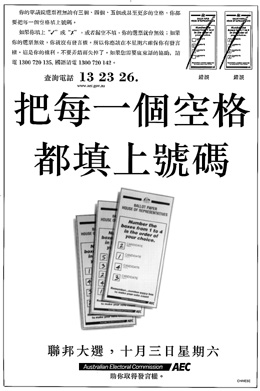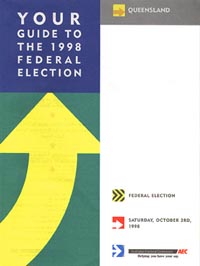Australian Electoral Commission


The AEC conducted an extensive public information campaign for the 1998 federal election to increase public understanding of, and participation, in the election.
The aims of the campaign were to ensure all eligible electors were informed and understood what was required of them to fully participate in the election and the range of services to which they had access to. The major messages conveyed in the campaign were:
The AEC used a number of strategies to communicate to electors including advertising, public relations, publications, national telephone enquiry service and the Internet. There were also a number of specific activities directed at the key target groups of electors from non-English speaking backgrounds, electors with a disability, Aboriginal and Torres Strait Islander electors and young electors.
The AEC's advertising campaign for the 1998 federal election consisted of national and State and Territory based advertising.
The advertising campaign which ran throughout the election period was designed to reach all eligible electors and cost a total of $8.7 million.
The national advertising campaign was divided into three main phases of:
The national campaign consisted of six television commercials, nine radio commercials and twelve press advertisements.
An AEC enrolment advertisement appeared on television in every major capital city on the night of Sunday 30 August 1998, the same day the election was announced. The final AEC advertisements appeared in the press and were broadcast on television and radio on polling day.
The State and Territory based advertising was designed to support the national advertising by providing local information. It included the press advertising of pre-poll voting arrangements and the listing of polling places in State, regional and local press.
The national advertising was translated into 18 languages in the ethnic press, 23 languages on ethnic radio and seven languages for ethnic television. In addition, radio advertisements were translated into 15 indigenous languages and advertisements were broadcast on Radio for the Print Handicapped.
Of the total media budget, 55 percent was spent on television, 16 percent on radio, 28 percent on press advertising and one percent on outdoor advertising. Expenditure in ethnic and indigenous media accounted for approximately nine percent of advertising costs.


| The press advertisements were translated into 18 languages: | The radio advertisements were translated into 23 languages: | The televisions advertisements were translated into seven languages: | The radio advertisements were translated into 15 indigenous languages: |
|---|---|---|---|
| Cantonese | Cantonese | Cantonese | Aboriginal Kriol |
| Vietnamese | Mandarin | Mandarin | Walmajarri |
| Spanish | Vietnamese | Vietnamese | Mudi |
| Korean | Spanish | Spanish | Arrente |
| Arabic | Korean | Italian | Walpiri |
| Greek | Arabic | Arabic | Yumbla Tok |
| Portuguese | Khmer (Cambodian) | Greek | Pidgin |
| Turkish | Thai | Karrijari | |
| Polish | Greek | Yaru | |
| Macedonian | Portuguese | Pitjanjarra Lurita | |
| Russian | Turkish | Kala Kawa Ya | |
| Italian | Polish | Tiwi | |
| Croatian | Indonesian | Torres Strait Kriol | |
| Serbian | Macedonian | Gumatji | |
| Farsi (Persian) | Russian | Berrara | |
| German | Italian | ||
| Hungarian | Croatian | ||
| Maltese | Serbian | ||
| Loatian | |||
| Farsi (Persian) | |||
| German | |||
| Hungarian | |||
| Maltese |
The AEC undertook wide ranging public relations activities during the election period to compliment the advertising and other elements of the public information campaign.
The public relations activities included:
The AEC produced a number of publications for the 1998 federal election including:

The AEC distributed a multi-page election information leaflet, Your guide to the 1998 federal election, to over seven million households throughout Australia in the weeks before polling day.
A different version of the leaflet was produced for every State and Territory and contained electoral information on how and when to vote, how votes are counted and important AEC contact details. The Queensland, Western Australian and Australian Capital Territory leaflets included maps showing the divisional boundaries following the redistributions.
The leaflet also included key information in 14 community languages and listed the 15 language specific numbers of the national telephone interpreting service.
Delivery of the over seven million leaflets began three weeks before polling day with householders in remote communities receiving the first copies. Delivery was extensive, covering urban, rural and remote households. The leaflets were wrapped in plastic to protect them and keep them separate from party political and other advertising material being delivered.
The information leaflet was also recorded on audio cassette and computer disc and distributed to blind and other print handicapped electors.
A national telephone enquiry service operated throughout the election period to provide information and assistance to the public. The national '13 23 26' number operated from 8am to 6pm seven days a week, the first time during a federal election period that the service was available on every weekend. The service also operated until 8pm on certain key dates such as the close of rolls.
A telephone enquiry centre was set up in each State and Territory capital city, with at any one time over 150 trained telephone operators answering calls around Australia. The service answered a record number of 533 451 calls nationally over the election period.
The national telephone enquiry service was designed to handle the maximum number of calls possible and to minimise the number of callers being placed in a queue. An overflow system was set up so that callers would first be connected to the State or Territory enquiry centre but if that line was busy they would be diverted to the national overflow centre in Canberra. The overflow centre in Canberra handled approximately 15 percent of all calls made to the enquiry service.
Another measure introduced to increase the number of calls the service could handle was an interactive desktop information-retrieval system. Using this system, the telephone operators were able to access information on their computer screen, replacing the time-consuming paper based materials used in the past.
A telephone interpreting service for electors from non-English speaking backgrounds was also provided throughout the 1998 election period.
The service had 15 language specific telephone lines and one line for electors who did not speak any of the 15 specific languages available. A caller to one of the 15 language specific lines was greeted by a recorded electoral message in their own language and could be connected to an operator speaking their language if they required further information.
During the election period a total of 6 380 calls were made to the interpreting service with over half of these callers choosing to speak further to an operator. The language lines that received the most calls during the period were the Mandarin, Cantonese and Vietnamese lines.
Just prior to the 1998 federal election, the AEC launched an expanded and redesigned Internet website. The upgraded site consisted of large amounts of current and historical electoral information with extensive cross-referencing to make it easy for users. The website at www.aec.gov.au was first launched at the 1996 federal election.
The Internet website proved to be an important way that the AEC provided information on the 1998 election to many people – including the media, Australians overseas, candidates and parties and members of the public. During the election period, over 115 000 people accessed over 525 000 page views with the average user spending 17 minutes looking around the site.
The website contained extensive 1998 election information and was continually updated throughout the period. For the first time at a federal election, the site included:
On election night the AEC hosted the largest live Internet event ever in Australia with the 'virtual tally room' at election.aec.gov.au. This website meant people from home could access up-to-the-minute election results soon after they were available on election night and in the weeks following. The site was updated every three minutes on election night and on a very regular basis in the weeks following.
The website greatly enhanced the access that the media, political parties, candidates and other interested people had to timely progressive election results. On election night and in the month following, more than 188 000 people accessed over three million page views on the site.
The AEC's public information campaign included a number of specific activities directed at meeting the needs of particular target groups. These activities were aimed at minimising any impediments these electors had to receiving and understanding information and in participating in the election.
In addition to advertising in the ethnic media and the telephone interpreting service, key election information was sent to ethnic media, community organisations and groups throughout the election period.
In the Division of Fowler, which has a high population of electors from non-English speaking backgrounds and past high informality rates, the AEC trialed an additional information measure on polling day. In selected polling places television screens were set up and played in several languages the advertisements explaining how to vote formally.
Just before the 1998 federal election the AEC undertook a pre-election Remote Area Information Program in the remote areas of Queensland, Western Australia, South Australia and the Northern Territory. The program employed indigenous people for a period of six weeks to visit remote indigenous communities to explain our electoral system and how to fully participate. Posters, pamphlets and videos were used to support the program.
Radio advertising in 15 indigenous languages was also broadcast on indigenous media during the 1998 election.
The AEC in consultation with the Royal Blind Society undertook a number of activities to assist electors with a print disability during the 1998 election. Audio cassettes and ASCII computer discs of the information contained in the elector leaflet were distributed to disability organisations and agencies, libraries and individuals. The availability of these leaflet formats was specifically advertised through the Radio for the Print Handicapped network, other disability media and in AEC publications.
Key election information was also distributed to disability organisations and media throughout the election and an '1800' number was available for electors to ring for information.
In addition, the national advertising campaign included advertising on the Radio for the Print Handicapped network in all phases of the campaign.
The AEC conducted a number of activities targeted at encouraging young people to participate in the 1998 election. A new youth television advertisement designed to encourage young people to enrol was placed during youth programming in the close of rolls week. Four new youth radio commercials were also broadcast throughout the election period.
As part of the public relations campaign, information, stories and photo opportunities were developed specifically for youth media outlets and the Internet was heavily promoted.